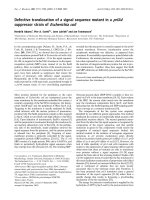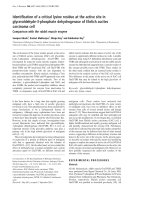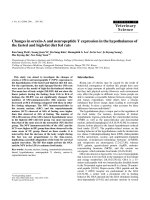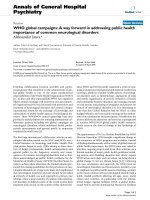Báo cáo y học: "Chiropractors in Finland – a demographic survey" pdf
Bạn đang xem bản rút gọn của tài liệu. Xem và tải ngay bản đầy đủ của tài liệu tại đây (211.2 KB, 5 trang )
BioMed Central
Page 1 of 5
(page number not for citation purposes)
Chiropractic & Osteopathy
Open Access
Research
Chiropractors in Finland – a demographic survey
Stefan Malmqvist*
1
and Charlotte Leboeuf-Yde
2
Address:
1
Ruoholahden Kiropraktikkokeskus (Private practice), Itämerenkatu 12, 00180 Helsinki, Finland and
2
Nordic Institute for Chiropractic
and Clinical Biomechanics, part of Clinical Locomotion Science, University of Southern Denmark, Denmark
Email: Stefan Malmqvist* - ; Charlotte Leboeuf-Yde -
* Corresponding author
Abstract
Background: The Finnish chiropractic profession is young and not fully accepted by Finnish
healthcare authorities. The demographic profile and style of practice has not been described to
date. However, as the profession seems to be under rapid development, it would be of interest to
stakeholders, both chiropractic and political, to obtain a baseline description of this profession with
a view to the development of future goals and strategies for the profession. The purpose of this
study was to describe the chiropractic profession in Finland in relation to its demographic
background, the demographics of their clinics, practice patterns, interactions with other health care
practitioners and some of the professions' plans for the future.
Methods: A structured questionnaire survey was conducted in 2005, in which all 50 members of
the Finnish Chiropractic Union were invited to participate.
Results: In all, 44 questionnaires were returned (response rate 88%). Eighty percent of the
respondents were men, and 77% were aged 30 to 44 years old, most of whom graduated after 1990
with either a university-based bachelors' or masters' degree in chiropractic. Solo practice was their
main practice pattern. The vast majority described their scope of practice to be based on a
musculoskeletal approach, using the Diversified Technique, performing Soft Tissue Therapy and
about two-thirds also used an Activator Instrument (mechanical adjusting instrument). The mean
number of patient visits reported to have been seen weekly was 59 of which nine were new
patients. Most practitioners found this number of patients satisfactory. At the initial consultation,
80% of respondents spent 30–45 minutes with their patients, 75% spent 20–30 minutes with "new
old" patients and on subsequent visits 80% of respondents spent 15–30 minutes. Interactions with
other health care professions were reasonably good and most of chiropractors intended to remain
within the profession.
Conclusion: The Finnish chiropractic profession is relatively young. Consequently, many of the
practitioners have a university-degree, which reflects recent developments in undergraduate
chiropractic education. Their practice profile and the manner in which they practice appear to be
fairly traditional.
Background
Finland is a country situated in the north of Europe, con-
sisting of approximately 5 million inhabitants. The cli-
mate is characterized by cold winters and relatively warm
Published: 27 August 2008
Chiropractic & Osteopathy 2008, 16:9 doi:10.1186/1746-1340-16-9
Received: 9 April 2008
Accepted: 27 August 2008
This article is available from: />© 2008 Malmqvist and Leboeuf-Yde; licensee BioMed Central Ltd.
This is an Open Access article distributed under the terms of the Creative Commons Attribution License ( />),
which permits unrestricted use, distribution, and reproduction in any medium, provided the original work is properly cited.
Chiropractic & Osteopathy 2008, 16:9 />Page 2 of 5
(page number not for citation purposes)
summers. Most inhabitants, 95%, speak Finnish, a lan-
guage that is difficult to learn for foreigners since its
vocabulary lacks common roots with most other Euro-
pean languages, and has a structure that differs signifi-
cantly from the classical languages. English was not taught
as a foreign language to all primary school pupils until the
early 1970s. As a result the Finnish people was not
strongly influenced by the Anglo-American culture.
The previous main sources of income were forestry, agri-
culture, fishery and heavy industry. In the period between
its liberation from Russia in 1917 until World War II, the
economy was weak. Finland was deeply scarred by its par-
ticipation in World War II, and the economy improved
only slowly thereafter, partly due to the large post-war
"fine" that had to be paid to the Soviet Union. Over the
past decades, an advanced electronic industry has devel-
oped and much of the rural population has become
urbanized. The standard of living is now high, as is the
educational standard, and much emphasis is put on vari-
ous public health measures [1-3].
Traditionally, folk medicine has played a large role, and
still does, particularly among people in the rural areas. It
is therefore not surprising that Finland was late to "dis-
cover" chiropractic. Not until in the early 1950s did the
first North American-educated chiropractor set up prac-
tice, followed by a second chiropractor 20 years later. Sub-
sequently, the profession grew very slowly with
competition from folk healers and manual therapists,
who were typically trained through weekend courses.
Attempts have been made to ensure a world-wide mini-
mum standard for all chiropractic institutions, through
the use of an eductional control organisation, the Council
on Chiropractic Eduction (CCE). There are branches in
different parts of the world, and the European branch
(ECCE) inspects and certifies all European chiropractic
institutions, whether private or state funded. Chiropractic
educational institutions that have achieved full certific-
tion by the ECCE are the Anglo-European College of Chi-
ropractic, UK, the University of Glamorgan, UK, l'Institut
Franco Européen de Chiropratique, France, and the Uni-
versity of Southern Denmark, Denmark. There is no
ECCE-approved chiropractic education in Finland, so a
chiropractic degree must be obtained in foreign countries.
During the late 1980s and early 1990s legislation for chi-
ropractors was introduced in the other Nordic countries.
In Finland, a new law introduced in 1994 licenced chiro-
practors with an academic degree from foreign chiropracic
educational institutions, and grants were made available
for students to study chiropractic abroad. The legal situa-
tion for the chiropractic profession has improved, but the
working conditions are still unsatisfactory. Although the
professional title recently became protected by law, chiro-
practors are unable to refer patients to other health care
providers, cannot perform their own radiological exami-
nation, do not have direct access to imaging services, and
may not prescribe sick leave. Unlike in the other Nordic
countries, chiropractic patients in Finland are not entitled
to government-subsidized reimbursement.
Despite this situation, the size of the Finnish Chiropractic
Union membership has, according to personal communi-
cation with its secretariat, increased five-fold during the
last 15 years. To date there are, according to communica-
tion with the Finnish National Authority for Medicolegal
Affairs, 70 chiropractors in Finland with either a DC
degree or an academic chiropractic degree, of which 52
(Jan 2008) are members of the Finnish Chiropractic
Union.
It was the purpose of this study to describe the chiroprac-
tic profession in Finland, in terms of demographic and
educational background. The demographics of their clin-
ics included location, practice pattern, interactions with
other health care practitioners, and some of the chiroprac-
tors' plans for the future.
Methods
A survey was conducted using a structured questionnaire
[Additional file 1: Demographic questionnaire for chiro-
practors in FCU]. All chiropractors who at the time of the
study were members of the Finnish Chiropractic Union
(N = 50) were invited to participate. The selection of par-
ticipants was limited to members of the Finnish Chiro-
practic Union to ensure participation of graduates from
CCE/ECCE accredited educational institutions.
Appropriately qualified graduates who were non-mem-
bers of the Finnish professional association were not
approached because they, from experience, are unwilling
to participate in any communal activities. The question-
naire was first tested in a pilot study on 10% of the mem-
bers for face validity, and the main survey was then
administered in June 2005.
Approval was sought from the Helsinki University Ethics
Committee, but because the survey was considered a qual-
ity assurance project approval was not needed. However,
all questionnaires were coded to avoid recognition of
respondents and the code key was destroyed when data
collection was completed. Return of questionnaire
implied consent from the participant. In order to respect
the anonymity of the participants, in such a small group
of practitioners, no comparison was made between
responders and non-responders.
Chiropractic & Osteopathy 2008, 16:9 />Page 3 of 5
(page number not for citation purposes)
Data were entered into the SPSS 11.0 spreadsheet by a per-
son experienced in data entry. Eleven questionnaires were
randomly selected and each item was manually checked
versus the entered data. No errors in the data entry were
identified, which was considered satisfactory.
Therefore it was not considered necessary to undertake a
double entry.
Analysis was done using SPSS 11.0 and Minitab. Some of
the variables were grouped into fewer categories, based on
the frequency of responses. The results were reported as
descriptive data in tables and summarized in the text.
Results
Description of study sample
Forty-four of the 50 distributed questionnaires were
returned, a response rate of 88%. Eighty percent of the
respondents were men and 77% were aged 30 to 44 years
[Additional file 2]. Eighty percent practised in a city sub-
urb or city center. Forty-eight percent had one practice
only, followed by 40% with two practices, and 12% with
more than two practices. However, about one third
expected to enter a partnership with a colleague within the
next two years. Forty-five percent worked together (in the
same clinic) with another health care provider and
another 25% expected to do so within two years. Two of
the respondents expected not to be working as a chiro-
practor at that time.
Fourteen percent employed a (non-chiropractic) assistant
and a further 23% expected to do so within the next two
years. About half had access to a receptionist. The majority
(77%) graduated between 1990 and 2004 and 53%
reported to have practised actively for a maximum of 10
years [Additional file 3]. Only 32% had a diploma of Doc-
tor of Chiropractic, the remaining had either a university-
based bachelor or master degree. Nine percent would con-
sider undertaking an additional university degree. In addi-
tion, almost half of the members subscribe to a
professional journal, usually the Journal of Manipulative
and Physiological Therapeutics. In relation to interactions
with other health care professions, these seem to be rea-
sonably good [Table 1]. For example, the mean number of
conversations/phone calls with other health care person-
nel in the past week was 3.3.
Scope of practice
The survey instrument also included questions on scope
of practice, type of technique used, and adjunctive thera-
pies used [Additional file 4]. The vast majority described
their scope of practice to be based on a musculoskeletal
approach. Almost all used the Diversified Technique, the
vast majority performed Soft Tissue Therapy, and about
two-third also made use of an Activator Instrument.
Various adjunctive therapies were used but none of these
was used by all or even by the majority. Ice was most com-
monly reported, by 46%. Seventy-seven percent had a
viewing box for radiology readings, 40% had the possibil-
ity to, indirectly, refer patients for X-ray examination via
medical practitioners, of which 9% could refer for MRI or
CT scans, whereas the use of ultrasound was very rare.
Patients
The mean and median patient numbers, respectively, dur-
ing the third week of 2005 was reported to be 59 and 47.
However, there was a wide range, from 5 to 228. The
mean and median number of new patients in that week
was 9 and 2, respectively, indicating that the spread of
data were skewed. The number of new patients in the past
week preceding the study was also stated to be 9.
Eighty percent of the participants spent 30–45 minutes
with their patients at the first visit, 75% spent 20–30 min-
utes on "new old" patients, whereas in subsequent visits
Table 1: A description of professional interactions between 44 Finnish chiropractors and other health care practitioners.
Variables Subgroups Frequency Percentage
Received at least one referral last week from Medical practitioner 28 64
Physiotherapist 12 27
Masseur 23 52
Sent at least one report in relation to referral last week Yes 18 41
No 26 59
Had at least one conversation/phone call with other health care personnel last week Yes 23 52
No 21 48
Quality of co-operation with other health care providers Mainly good 21 48
Both good and bad 12 27
Mainly lack of co-operation 11 25
Chiropractic & Osteopathy 2008, 16:9 />Page 4 of 5
(page number not for citation purposes)
80% of respondents spent 15–30 minutes. At one
extreme, one respondent reported spending one minute
only on subsequent visits. The number of patient seen
wasconsidered to be "about right" by 55%, and 9%
reported they were seeing more patients than they would
like to. However, about one third (36%) would have been
happy to see some more patients.
Eighty percent had the (mandatory) malpractice insur-
ance, 73% had a private pension scheme and almost as
many (68%) had a private health care insurance.
Discussion
The Finnish Chiropractic profession is relatively young
and small, compared to other national chiropractic asso-
ciations in Europe, and the demographics and practice
procedures of the profession have never previously been
documented [4]. Perhaps for this reason, Finnish chiro-
practors were eager responders to this survey with 88%
returning the questionnaire.
According to the present survey, the members of the Finn-
ish Chiropractic Union consisted of mainly young men
(80%), who, in the majority of cases, graduated from uni-
versity based or university affiliated chiropractic institu-
tions. Information acquired from the administrative
offices of corresponding associations in Sweden, Norway
and Denmark reveals a different gender distribution, with
70%, 71% and 51%, respectively of men in the three
countries. The proportion of male practitioners was lower
(63%) also in a recent study of German chiropractors
(response rate 72%) [5].
Despite the young age of the Finnish chiropractors, their
current practice pattern was similar to that of the early
years of chiropractic in Finland. Typically a Finnish chiro-
practor is working in solo practice, sharing his time
between one or two practices. Sixty percent reported work-
ing in a solo practice, whereas, according to a previous
study (response rate 70%), the estimated proportion was
41% among European chiropractors in general [6]. In the
more recent German study, 45% of the respondents
worked in a solo practice setting [5].
The Finnish Chiropractic Union subscribe to the Chiro-
practic Report for its members, a cost that is included in
the membership fee. Additionally does almost 50% of the
members subscribe to one more professional scientic
journal. The Finnish chiropactor thus seem to be academ-
ically updated. However, regarding future development is
only a small number interested in further education at a
university level. This is understandable at the present
time, considering the isolated position of the chiropractic
profession, and the absence of chiropractic academic
institutions in Finland. The time, money and effort spent
on further education, would lead to no additional career
possibilities.
Respondents were satisfied with the number of patients
and they seemed to enjoy reasonable contacts with other
health care practitioners. This may indicate that their pro-
fessional activities are felt to be fulfilling. Nevertheless,
two of the respondents were planning to leave the profes-
sion, although they were not close to retirement age.
Most reported to have a musculoskeletal approach, using
mainly Diversified Manipulation Technique, Soft Tissue
Techniques and Activator Instrument. These are methods
previously reported frequently to be used in Europe [5-7].
The use of adjunctive therapies showed a less distinct pat-
tern, perhaps because chiropractors determined that dif-
ferent patients require different approaches. It was also
interesting that about one-third of the respondents had
some sort of rehabilition equipment in their clinic, indi-
cating that they also have the facility to assist patients with
general or specific training following the acute treatment
stage.
Regarding professional activities, only some of our data
are comparable with information from previous Euro-
pean surveys, such as time spent with patients. The time
spent on the first visit appeared to be similar in Finland
and the Netherlands (36 and 41 minutes, respectively)
[8]. Subsequent visits took 22 minutes in Finland and 15
minutes in the Netherlands.
Most of the Finnish chiropractors had made sure that they
were covered with insurances both for pension scheme
and private healthcare but, a small number appeared not
to have the obligatory malpractice insurance.
The limitations of this study are that, despite the high
response rate, not all chiropractors with a CCE/ECCE-
approved education are members of the Finnish Chiro-
practors' Union and that not all members of the profes-
sional association participated in the survey. It is possible
that non-participants in the study have a profile that dif-
fers from that of the responders. Other limitations are, of
course, that the questionnaire was not exhaustive. For
example, the description of practice procedures might
have been designed differently by other groups of
researchers, and the participants were not encouraged to
extend their answers beyond the the questions stated in
the questionnaire. Therefore, it is possible that some
nuances of clinical practice failed to be recorded. How-
ever, the results of the pilot testing of the survey instru-
ment did not indicate that the questionnaire failed to
provide meaningful answering options.
Publish with BioMed Central and every
scientist can read your work free of charge
"BioMed Central will be the most significant development for
disseminating the results of biomedical research in our lifetime."
Sir Paul Nurse, Cancer Research UK
Your research papers will be:
available free of charge to the entire biomedical community
peer reviewed and published immediately upon acceptance
cited in PubMed and archived on PubMed Central
yours — you keep the copyright
Submit your manuscript here:
/>BioMedcentral
Chiropractic & Osteopathy 2008, 16:9 />Page 5 of 5
(page number not for citation purposes)
Conclusion
The educational background of the chiropractic partici-
pants in this study reflects the recent development in chi-
ropractic education, with university affiliations and
masters degrees. Although the Finnish chiropractic profes-
sion is relatively young, these chiropractors appeared to
have a traditional practice profile: solo practice, a muscu-
loskeletal approach, allowing good time for examination
and treatment.
Competing interests
The authors declare that they have no competing interests.
Authors' contributions
SM was responsible for planning and executing the demo-
graphic survey, participated in the data collection and
drafted the manuscript. CL–Y supervised the process. Both
SM and CL–Y participated in the design of the study and
performed the analysis. Both authors read, finalized and
approved the final manuscript.
Additional material
Acknowledgements
The authors would like to acknowledge the assistance of the chiropractors
who participated in the survey and, in particular, the members of the
Research Group of the Finnish Chiropractic Union, who helped collect the
data.
References
1. OECD: PISA 2006 – Science Competencies for Tomorrow's World: Volume
1 Analysis OECD Publishing; 2007.
2. OECD: PISA 2006 – Volume 2: Data OECD Publishing; 2007.
3. National Public Health Institute: Research, People & Pro-
grams [ />research__people___programs]
4. The European Chiropractors' Union [
]
5. Schwarz I, Hondras MA: A survey of chiropractors practicing in
Germany: practice characteristics, professional reading hab-
its, and attitudes and perceptions toward research. Chiropr
Osteopat 2007, 15:6.
6. Pedersen P, Breen AC: An overview of European chiropractic
practice. J Manipulative Physiol Ther 1994, 17(4):228-37.
7. Assendelft WJJ, Pfeifle CE, Bouter LM: Chiropractic in the Neth-
erlands: A survey of Dutch chiropractors. J Manipulative Physiol
Ther 18:129-34.
8. Rubinstein S, Pfeifle CE, van Tulder MW, Assendelft WJ: Chiroprac-
tic patients in the Netherlands: a descriptive study. J Manipu-
lative Physiol Ther 23(8):557-63.
Additional file 1
Demographic questionnaire for chiropractors in FCU. A translation of the
original Finnish questionnaire.
Click here for file
[ />1340-16-9-S1.doc]
Additional file 2
Table 2. Description of 44 Finnish chiropractors and their practice pat-
terns, I.
Click here for file
[ />1340-16-9-S2.doc]
Additional file 3
Table 3. Description of 44 Finnish chiropractors and their practice pat-
terns, II.
Click here for file
[ />1340-16-9-S3.doc]
Additional file 4
Table 4. A description of scope of practice, techniques and adjunctive ther-
apies used according to a survey of 44 Finnish chiropractors.
Click here for file
[ />1340-16-9-S4.doc]









